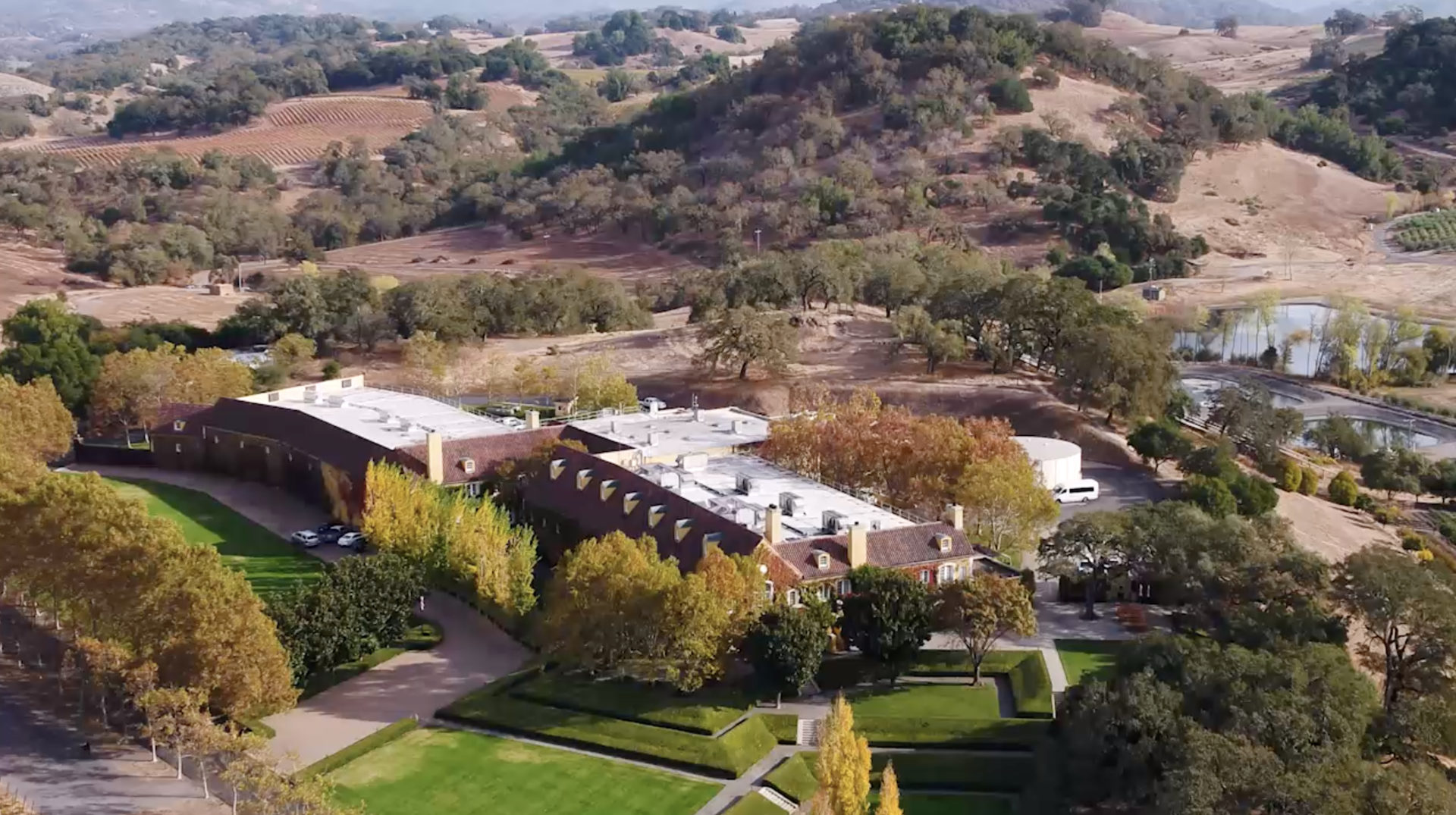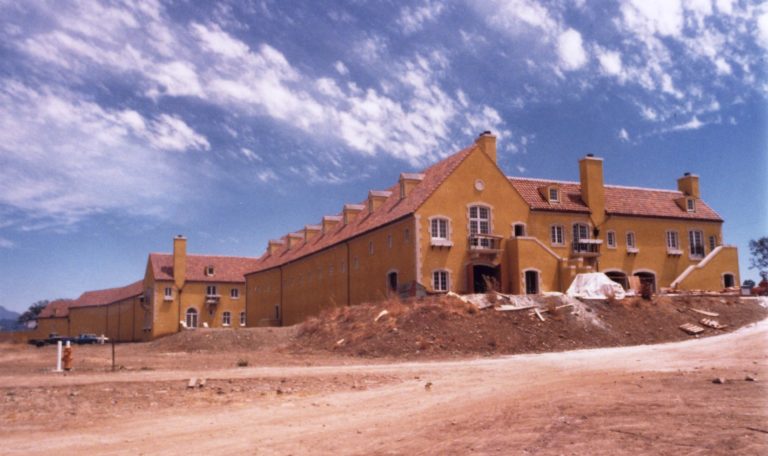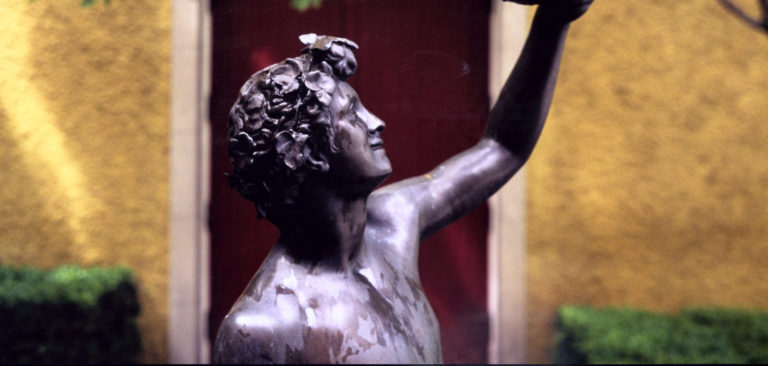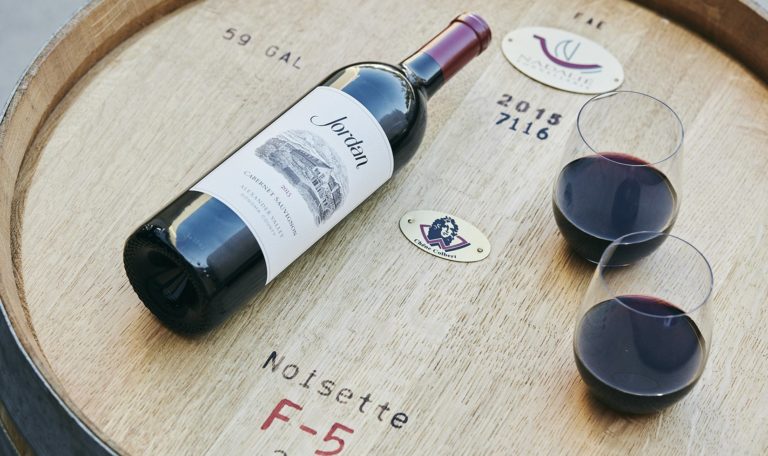Because we’ve been in the wine business for almost 50 years, there are many milestones in Jordan Winery’s history. This historic time line is a summary of achievements by year since our founding in 1972. Dig deeper into our history with the story behind the creation of Jordan Winery and our most significant milestones.
Jordan Winery History: Time Line of Events
1972
Tom and Sally Jordan establish Jordan Vineyard and purchase 275 acres on the Alexander Valley floor.
John, Tom and Sally’s son, is born the same day (May 25) the deed is signed on the land that becomes Jordan’s valley floor vineyards.
The Jordans plant first cabernet sauvignon and merlot vines.
1974
The Jordans decide to start a winery and acquire 1,300 acres in Alexander Valley, today home to the Jordan Estate.
André Tchelistcheff is hired as consulting winemaker.
Architect Bob Arrigoni is hired, and construction of the 58,000-square-foot winemaking, warehouse, administration, culinary and hospitality facility begins.
1976
Rob Davis is hired as winemaker.
Winemaking portion of Winery Chateau is completed one week before harvest begins.
First cabernet sauvignon and merlot grapes are harvested to create the inaugural vintage of Jordan Cabernet Sauvignon Alexander Valley.
Henri Charvet of Aix-en-Provence, France, is hired as executive chef.
Artist Ralph Colonna commissioned to design the Jordan wine label.
1977
Jordan plants its first chardonnay vines in Alexander Valley. The Jordans finish interior design of culinary and hospitality facilities on the estate.
1978
Construction begins on the family residence at Jordan Estate, also designed by Bob Arrigoni.
First vintage of Jordan Cabernet Sauvignon labeled “Estate Bottled.”
1979
First chardonnay grapes are harvested to create the inaugural vintage of Jordan Chardonnay.
1980
The inaugural 1976 Jordan Cabernet Sauvignon is released.
1981
The inaugural 1979 Jordan Chardonnay is released.
1983
Jordan’s 1979 Cabernet Sauvignon receives “Best Cabernet in America” award and a platinum medal from the Beverage Tasting Institute in Hyde Park, New York.
1984
Canada becomes Jordan’s first international market.
1986
Jordan wines are served at the White House President’s and Vice President’s Inaugural Anniversary Dinner Dance (also served in 1988).
1987
Jordan wines are served at the White House for guest Mikhail Gorbachev, President of the Soviet Union.
Cabernet franc introduced to the Jordan Cabernet Sauvignon blend.
Tom Jordan begins a sparkling wine experiment, called J. The Jordan’s oldest daughter, Judy, expresses interest in running the family’s sparkling business.
1988
The Jordans bring the first French Coquard sparkling wine press to the United States for J.
1990
Jordan Cabernet Sauvignon earns No. 1 ranking in first-ever Wine & Spirits annual Restaurant Poll (also ranked No. 1 in 1991, 1992, 1993, 1994, 2001, 2002, 2003, 2004, 2008, 2011, 2012, 2013, 2014, and 2015).
Jordan sources its first Russian River Valley Chardonnay grapes from Judy Jordan’s J vineyards.
1993
Jordan wines are served at the Academy Awards Governors Ball (also served in 1994, 1995, and 1996).
Last vintage of Jordan Cabernet Sauvignon designated “Estate Bottled.”
J sparkling production moves from Jordan to its own facility in the Russian River Valley.
1994
Jordan loses estate-grown status due to replanting after grapevines succumb to Phylloxera.
André Tchelistcheff dies at age 92.
1995
First Tuscan varietal olive trees are planted on the estate (Frantoio, Leccino, and Pendolino).
John Jordan graduates from Occidental College with a degree in economics.
1996
First hillside vines planted on the Jordan Estate (cabernet sauvignon, merlot, cabernet franc, and petit verdot).
Jordan Cabernet Sauvignon transitions to Sonoma County appellation due to vine replanting.
1997
The Jordan Estate vegetable garden is planted.
Tom Jordan purchases Piper Sonoma facility and 118 acres for J Sparkling, and Judy officially starts J Vineyards & Winery.
1998
Inaugural Jordan Estate Extra Virgin Olive Oil harvested.
1999
Jordan harvests first grapes from its estate hillsides.
Jordan achieves Sonoma Green Business Program certification.
Chef Udo Nechutnys joins Jordan to lead culinary program.
2000
Additional cabernet franc and petit verdot vines planted on Jordan Estate hillsides.
Chardonnay transitions to Russian River Valley appellation.
Jordan achieves Bay Area Green Business Program certification.
2002
Jordan Cabernet Sauvignon regains its Alexander Valley appellation status.
Petit verdot introduced to cabernet sauvignon blend.
John Jordan receives law degree from Empire College School of Law and a Master of Business Administration degree from the University of San Francisco.
Jordan removes all chlorine agents from facility.
Potable water system is revamped using ultraviolet technology.
2003
Todd Knoll joins the winery as chef de cuisine to Udo Nechutnys.
2004
First Spanish Arbequina trees planted on Jordan Estate.
2005
John Jordan takes over day-to-day operations of the winery and begins to acquire ownership.
John Jordan hires internal sales management team.
Jordan Chardonnay begins a transition toward less malolactic fermentation to retain its bright acidity and minerality.
Cabernet franc vines are replaced with petit verdot to bring its estate acreage to 21. Replanting continues into 2006.
Winemakers Rob Davis and Maggie Kruse create a “super blend” of Jordan Cabernet Sauvignon – comprised of their top vineyard blocks aged in the finest French oak. This begins a 10-year journey to elevate quality to even greater heights through vineyard and barrel sources.
2006
Winemaker Rob Davis harvests his 30th vintage at Jordan.
Jordan transforms its tour and tasting visitor experience.
First Jordan Alexander Valley Cabernet Sauvignon vintage to include malbec in the blend.
Nitsa Knoll joins as Director of Hospitality & Events.
2007
John Jordan takes full ownership of Jordan Vineyard & Winery.
Jordan begins energy efficiency initiatives, including new refrigeration, LED lighting retrofits, new piping system, new winery roll-up doors, and new heat-reflective “cool roof” for the entire facility.
Extensive waste water recycling program begins.
Todd Knoll promoted to executive chef.
2008
Jordan Estate Rewards program is launched.
Jordan joins Wine Industry Efficiency Solutions (WIES) program to audit energy usage and to monitor and implement additional energy-efficiency programs.
Brent Young joins as viticulturist.
2009
Extensive soil mapping study of Jordan Estate begins to further elevate quality of Jordan Cabernet Sauvignon through precision farming.
Jordan achieves carbon-neutral energy usage through PG&E’s ClimateSmart program. (PG&E ended the program in 2011.)
2010
Jordan decreases carbon footprint by 24 percent since 2006, continuing to elevate its initiatives to reduce, reuse, and recycle.
2012
The John Jordan Foundation is created to help fight the negative effects of poverty.
Jordan achieves Fish Friendly Farming certification.
Jordan receives Fish Friendly Farming Light Touch Award for its gentle touch on the land through sustainable farming.
Solar arrays installed to power more than 90 percent of the winery’s electricity needs.
“The Journey of Jordan” wins “Best Winery Blog” at the Wine Blog Awards (also won in 2013; blog won “Best Photo/Video on a Wine Blog” in 2013 and 2014).
2013
Jordan purchases a state-of-the-art wine bottling line from an Italian manufacturer to improve efficiency, precision and overall quality control.
Jordan named one of TripAdvisor’s Top 10 U.S. Winery Tours.
Jordan Estate Tour & Tasting debuts during harvest season.
2014
Wine Enthusiast magazine names Jordan “American Winery of the Year.”
After completion of a multi-year energy efficiency program and shift to solar, Jordan’s electrical use earns carbon neutral status.
Jordan becomes first property in Sonoma County to become Fish Friendly Ranching certified.
Valentine’s Dinner at Jordan and Sunset Supper at Jordan Vista Point culinary events debut.
2015
Jordan named most popular wine brand on U.S. restaurant wine lists in the Wine & Spirits 26th annual Restaurant Poll.
Judy Jordan, John’s sister, sells J Vineyards & Winery.
Jordan’s Estate Tour & Tasting nominated for Best Vineyard Experience in the inaugural Sunset Travel Awards.
First Starlight Supper at Jordan is held during Perseid meteor shower.
2016
Sonoma County Sustainable certification achieved.
Jordan named most popular Cabernet Sauvignon on U.S. restaurant wine lists in the Wine & Spirits 27th annual Restaurant Poll.
First apiary installed in Jordan garden, including the new Flow Hive beekeeping invention.
Jordan’s Estate Tour & Tasting nominated for Best Vineyard Experience in the second-annual Sunset Travel Awards.
Jordan receives TripAdvisor Certificate of Excellence award for fourth consecutive year (2013-2016).
Jordan Vineyard Hike experiences and Season of the Olives Celebration & Luncheon debut.
2017
Jordan Cuvée by Champagne AR Lenoble debuts to celebrate the partnership of Jordan and the Malassagne family in France.
Jordan releases its first Jordan Chef’s Reserve Caviar by Tsar Nicoulai, available exclusively at jordanwinery.com.
Jordan named Best Vineyard Experience in American Airlines’ Celebrated Living Magazine 2017 Platinum List Awards.
Jordan receives TripAdvisor Certificate of Excellence award for fifth consecutive year (2013-2017).
Jordan begins seven-year replant project of all Jordan Estate vineyards due to Red Blotch disease.
Jordan launches food, wine and travel website, winecountrytable.com.
2018
The Jordan Estate Rewards program celebrates its 10th anniversary.
The new six-acre Chateau Block on the Jordan Estate is planted to cabernet sauvignon. It is the first time that a vineyard has been planted next to the hilltop chateau.
Jordan named Best Vineyard Experience in American Airlines’ Celebrated Living Magazine 2018 Platinum List Awards.
Jordan Winery qualifies for TripAdvisor’s Certificate of Excellence Hall of Fame with sixth consecutive TripAdvisor Certificate of Excellence award (2013-2018).
Winemaker Rob Davis named one of the top 100 influential people in the U.S. wine industry today.
All Jordan Chardonnay grower vineyards are certified through California Sustainable Winegrowing Alliance (CSWA).
2019
Jordan dining room undergoes major remodel to further elevate culinary hospitality.
The first Jordan Cabernet Sauvignon aged entirely in French oak is released in May (2015 vintage).
Jordan Winery continues to be included in TripAdvisor’s Certificate of Excellence Hall of Fame with seventh consecutive TripAdvisor Certificate of Excellence award (2013-2019).
Jordan debuts new Chateau Block Cabernet Sauvignon Vineyard Tasting experience.
All Jordan Cabernet Sauvignon grower vineyards meet third-party certification standards through the California Sustainable Winegrowing Alliance (CSWA), Fish Friendly Farming or USDA Organic.
Jordan Vineyard & Winery is certified by the California Sustainable Winegrowing Alliance.
Rob Davis retires at end of his 43rd growing season; Maggie Kruse, who has worked alongside Davis for the last 13 harvests, promoted to winemaker.
2020
Jordan named most popular wine brand and no. 1 Cabernet Sauvignon in the Wine & Spirits 31st annual Restaurant Poll.
The 40th anniversary vintage of Jordan Cabernet Sauvignon is released in May (2016 vintage).
Devonna Smith joins as Chief Financial Officer.
First cabernet sauvignon harvest from the Chateau Block.
2021
Jordan purchases a 45-acre property in Alexander Valley, marking the first time that Jordan purchased land since the acquisition of the 1,300-acre Jordan Estate in 1974.
Jordan completes the first major renovation of its three guest suites.
The 40th anniversary vintage of Jordan Chardonnay is released in August (2019 vintage).
During the 2021 growing season, John Jordan and Maggie Kruse embark on a second “super blend” project – focusing on Jordan Chardonnay. To elevate quality even further over the next five years, experiments began with vineyard sites, clones and aging vessels.
2022
Jordan celebrates its 50th anniversary since the winery’s founding in 1972. Jordan Winery travels to Denver and Nashville for a series of culinary-focused and philanthropic events to celebrate this milestone.
The John Jordan Foundation celebrates its 10th anniversary.
Jordan Winery purchases eight concrete eggs to elevate the chardonnay program and enhance the richness, mouthfeel and delicate fruit flavors.
Jordan is included on the Wine & Spirits Top 100 list for the first time in 2022.
Jordan is named Monarch Sustainer of the Year by Pollinator Partnership. This award recognizes a business that has shown exceptional leadership and action in providing habitat for monarchs along their migratory corridors.
2023
Jesse Mallgren joins as executive chef.
First concrete egg art installation illustrated on Jordan’s concrete eggs by Matt Willey, The Good of the Hive.
After a six-month renovation, the Jordan Lobby and Guest Reception debuts June 2023. Designed by Maria Khouri Haidamus, the new guest reception features two sitting areas, a new retail boutique, an art collage, rare French antiques and more.
Jordan Winery partners with Smile Train and celebrity guest, Jordin Sparks to raise awareness and funds for the largest cleft-palate organization in the world.
The Jordan Chateau’s entrance and front lawn are reimagined and remodeled in the summer of 2023 and reopens as La Fougeraie (the fern garden) in August. Designed by landscape designer Christian Douglas.
Jordan is awarded the Best Wine Country Experience by San Francisco Magazine.
The 2019 Jordan Cabernet Sauvignon earns 96 points and the 2021 Jordan Chardonnay earns 94 points by The Tasting Panel.
Jordan is named #1 Vineyard Experience in North America and #20 in the world by World’s Best Vineyards in 2023.





